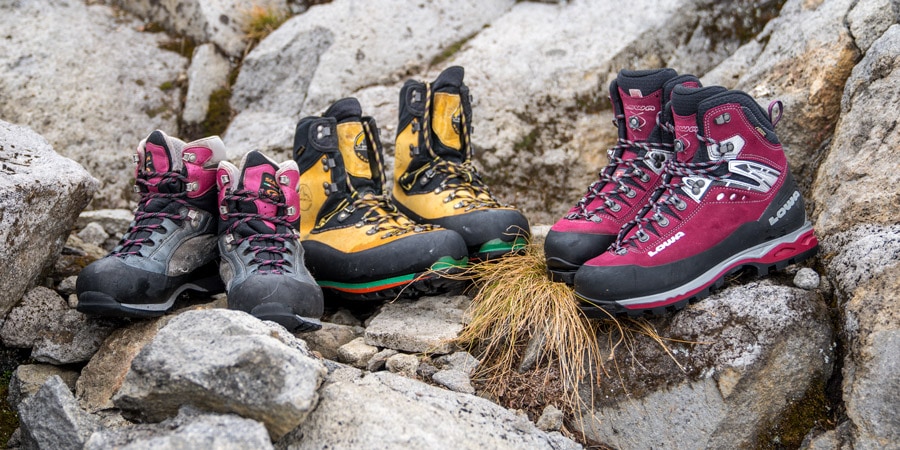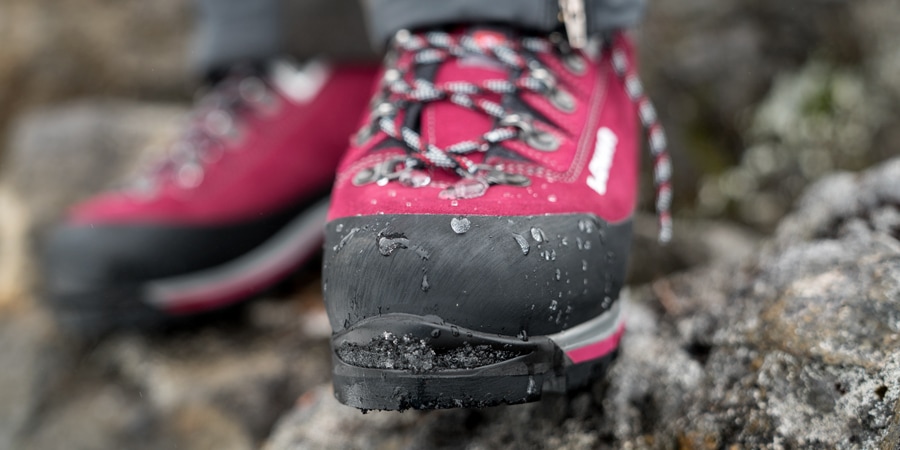Whether you go with a professional guide service, as the culmination of a mountaineering class or with some experienced friends, summiting your first snow-covered peak is a serious undertaking. And you're definitely going to need a pair of boots that are up to the task.
Before You Shop
Answering the following questions will help guide the route you take to get your mountaineering boots:
Should you rent or buy mountaineering boots? If you're going on a one-time trip with a guide service, then it'll be cheaper to rent boots for the limited number of days you'll be using them. Some guide services offer rentals; so do many REI Co-op stores. If you have a summer-long series of mountaineering classes and/or trips planned, then getting your own pair of boots is the smarter way to go.
Does your guide, instructor or mountaineering friend have specific requirements? Usually this is a matter of whether you'll be instructed to wear plastic boots versus insulated leather boots (or insulated boots made out of synthetic materials). Most rental boots are plastic boots because they're sturdy, warm and have a soft inner boot that doesn't require a break-in period to feel reasonably comfortable.
Are you hoping to use your mountaineering boots for hiking, too? If so, then look at lightweight, non-insulated boots, because they're lighter and more flexible than other types of mountaineering boots. Given the expense of mountaineering boots, it's understandable to want to use them for other activities. But mountaineering boots are designed specifically for summiting snowy peaks, so the more comfortable way to go is to buy boots specifically for mountaineering, and then plan to use another pair of hiking-specific boots on backpacking trips.
If you value a lower price and prefer a lighter boot, then a three-season boot is a good option. If you value warmth and hope to use the boots in a broad range of temperature conditions, then an insulated boot would work well.
Which come first, the crampons or the boots? Get the mountaineering boots first so that you can concentrate on getting a good fit. Then it's a simple matter of finding crampons that fit your boots. If you already own crampons that you plan to use, then you'll need to make sure your boots will work with the type of crampons you have. Note, too, that crampons can work with some rugged models of hiking boots. If you plan to summit a peak where a limited amount of snow or ice travel is required, this could be an option for you. To learn more about types of crampons, read How to Choose Crampons.
Does the boot fit? No matter what type of boot you get, this is ultimately the most important factor to consider. You'll be wearing your boots for multiple hours and hauling heavy loads. So before you rent or buy, go to an outdoor specialty shop and have them give you a precise fit appraisal.
Basic Types of Mountaineering Boots

Mountaineering boots for new climbers roughly break down into three categories:
Insulated boots
Multilayered construction (rather than having inner and outer boots).
- Provide a super-comfortable fit once they're fully broken in
- Waterproof, but the durable water repellent (DWR) finish needs periodic renewal
- Rugged leather (or synthetic material) resists abrasion
- Moderately warm (a few ultrawarm models actually have an insulated inner boot)
- Lighter than plastic boots and more suited to long approach hikes
- More expensive ($450ish and up) than three-season boots
Three-season boots
Your lightest option, they have no insulating layer.
- Provide a super-comfortable fit once they're fully broken in
- Your most lightweight option, their flexibility allows you to also use them for alternative activities like hiking and scrambling
- Waterproof, but the durable water repellent (DWR) finish needs periodic renewal
- Rugged leather (or synthetic material) resists abrasion
- Won't overheat feet in warm, midsummer conditions
- Moderately priced (typically less than $400)
Plastic boots
Hard-shell plastic on the outside with a soft inner boot.
- Not widely sold, but they're a staple of rental shops because they're durable and fit OK for one-time users
- Shell stands up to ice and abrasion well
- Waterproof shells slough off slushy snow when conditions warm up
- Ample warmth for cold conditions
- Soft inner boot is moderately comfortable without requiring a break-in period
- Moderately priced
- Heavy
- Used exclusively for mountaineering; not comfortable for long approach hikes
For most people the decision boils down to three-season (non-insulated) boots versus insulated boots. If you value a lower price and prefer a lighter boot, then a three-season boot is a good option. If you value warmth and hope to use the boots in a broad range of temperature conditions, then an insulated boot would work well.
You can also check out our selection of used gear.
What to Do After You Buy

Add Insoles to Improve Foot Support
Just as with hiking boots and other types of outdoor footwear, adding a pair of supportive insoles can improve comfort and performance. For guidance on selecting insoles, read How to Choose Insoles.
How to Break in Your Mountaineering Boots
Wearing your boots for the very first time on your summit climb is a recipe for misery. You want to give your boots time to mold to the shape of your foot, so wear them as much as possible prior to your class or trip. Time in the boots is more important than trail mileage, although taking some day hikes in them is also an excellent idea. Read How to Break in Hiking Boots for more tips, because the process is very similar for mountaineering boots.
How to Clean and Maintain Your Mountaineering Boots
Cleaning your boots: Dirt and grit can break down your boots, so it's important to clean them between climbs. A soft nylon brush and boot-cleaning products will do the trick. For tips on how to clean and condition boots, read How to Clean Hiking Boots.
Renewing the water-repellency on your boots: Even though most boots have a waterproof inner membrane, it's important to renew the exterior durable water repellency (DWR) of their leather (or synthetic leather). When you notice that drops actually soak into the surface of the boots (instead of beading up and rolling off), it's time to renew the DWR. Read How to Waterproof Your Boots for step-by-step instructions.


